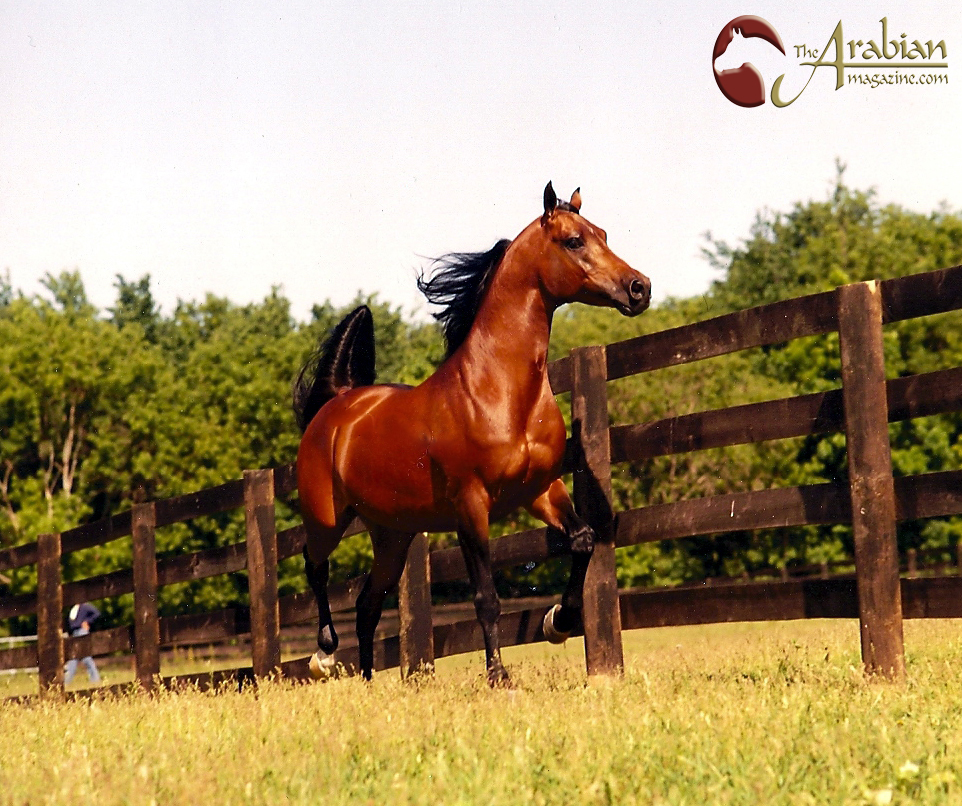Continuing our Throwback Thursday to Arabian icons we have celebrated in the pages of The Arabian Magazine over the years, we celebrate the iconic Russian stallion Menes. Please enjoy the second part of this fascinating feature on a true great.
And so, with Cindy by his side as she had been since he first arrived in Europe, Menes arrived in the United States on 18 December, 1983. Quarantine duly cleared, Menes arrived at Ventura Farms and, straight from a cold and damp Dutch winter, the California winter was positively tropical for the stallion and he quickly settled in. “Menes took it all in his stride, as was his way, and he grazed the days away in his personal paddock, oblivious to the many visitors who were beginning to show up as word leaked out that he was finally in the US,” recalls Cindy. “Before long, we were ready to fly to Chicago.
“On the flight to Chicago, it was just Menes, me and the farm veterinarian in the belly of the plane. I settled underneath the hay bag in Menes’ box and was, soon enough, covered in a small blizzard of bits of hay as Menes munched his way to Chicago. January in Chicago was quite a shock after California, but with his customary nonchalance, Menes – quilted in a few extra blankets – took up residence at Aries.”
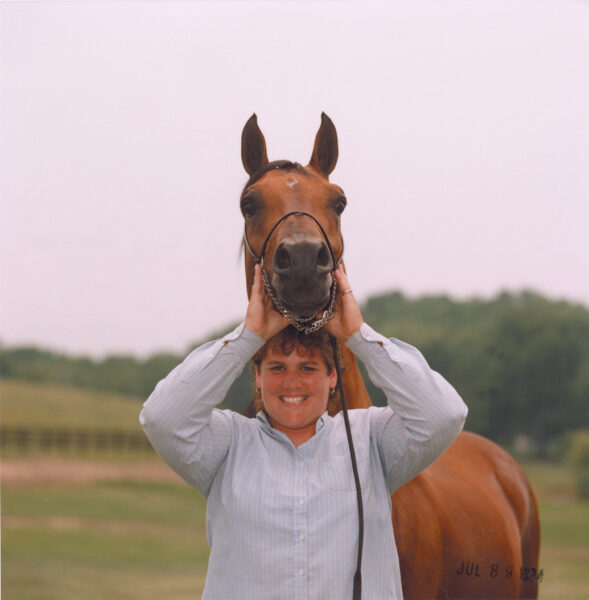
The arrival of Menes in the USA had, rightly, caused a stir among Arabian horse breeders in the country and the very best mares available were waiting for Menes when he arrived in Chicago. With the breeding season just a few weeks away, Michael and Cindy began to collect semen and test it in the Aries laboratory. A mini-crisis struck: the treatment for Piroplasmosis can leave stallions sterile, either temporarily or permanently. As they began to collect Menes’ semen, Michael and Cindy realised that they were in trouble and brought in several reproductive experts to evaluate things, with one saying that Menes would never be a fertile breeding stallion.
“We refused to give in – and no one told Menes,” says Cindy. “Mare owners were informed that his semen was of poor quality, but that we would do our best to get their mares in foal. They were also given an option to wait a year to see if his semen improved, and we ended up breeding 22 mares with 20 being confirmed in foal. The following season, his semen was excellent and he never looked back, breeding up to 100 mares a year.”
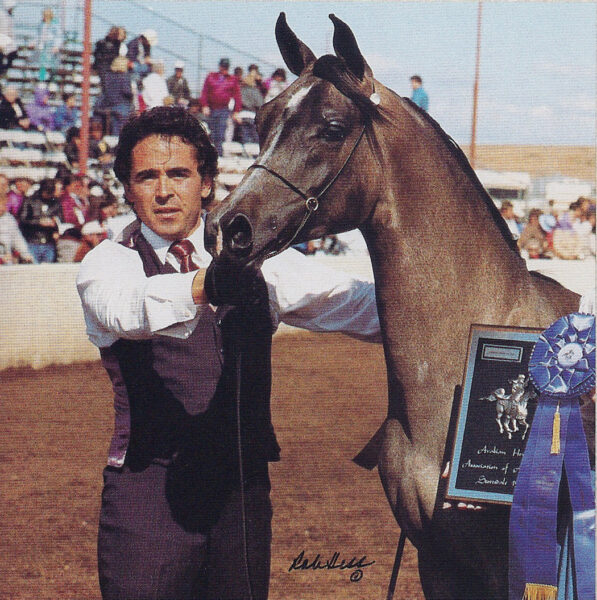
Of the many Menes foals born at Aries Arabians, Michael picks out the mare Parada as one of the standouts. Foaled in 1986, Parada is out of Polonia, out of Bint Pensja by National Champion Elkin and sired by US Reserve National Champion Stallion, Gwalior+++. As a yearling, Parada wowed the crowds at Scottsdale, taking the Junior Female Champion title as well as the Star World Grand Champion Mare honours. She later went on to be named US National Reserve Champion Futurity Mare. “The Parada wins are some of my best times with Arabian horses,” smiles Michael. “They just brought a tremendous amount of satisfaction, especially after the long struggle for the acquisition of Menes, the importation and then his early fertility problem.”

The influence of Menes was spreading across the world and top mares were being bred to him. From there, breeding programmes were developed based on Menes sons and daughters – such as Sax Arabians in Germany, where the foundation mare Menascha (ex Nascha by Neman out of Neschi), also foaled in 1986, has created a formidable legacy including her daughter, the European Triple Crown winner Essteema (by Essteem by Fame VF out of Raffoleta-Rose). Sax Arabians also ended up owning three further Menes daughters as well as the Menes son Vympel (ex Molva by Aswan out of Monopolia), known as the Black Prince of Tersk.
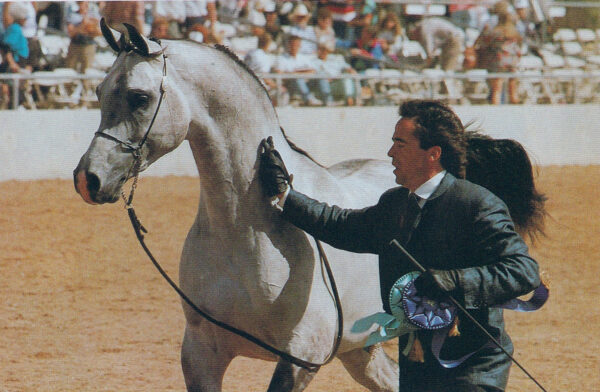
Other progeny of note in those early years include: Emperator, foaled in 1987 out of Ellavia (Stargard x Ellice by Negatiw out of Ellenai), who was crowned US National Champion Futurity Colt and Scottsdale Reserve Senior Grand Champion Stallion in 1990 as well as 1992 World Champion Stallion; the 1989 son Medalj (ex Sadza by Rusazcie out of Sagana), a six-time champion including World Junior Champion Stallion, International Junior Champion and a double Swedish National Champion; and Balaton (ex Panagia by Aswan out of Pustinia), who was crowned 1992 European Champion Stallion at 10 years of age.
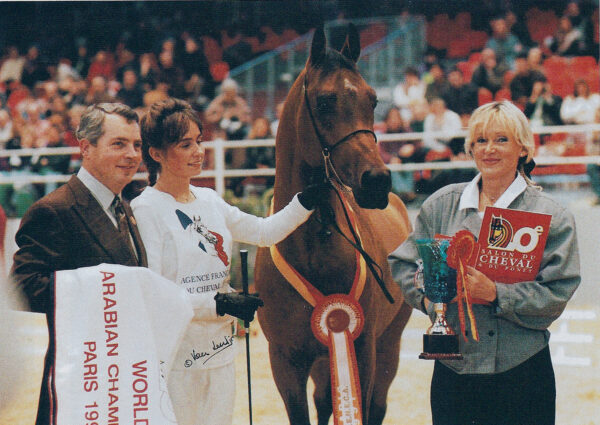
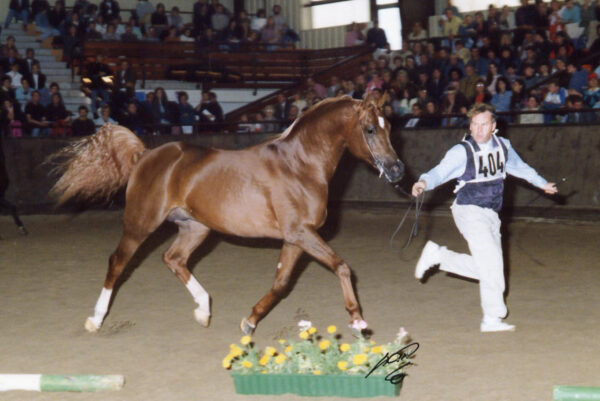
By the early 1990s, Menes had sired Swedish, British, German and Belgian National Champions, World Champions and European Champions. The time had come for him to return to Europe for a season, and Cindy Reich, who had left Aries some years before, received a telephone call, asking her to accompany Menes to Belgium, where he was being leased for a year to Arabica Stud. The following year, Menes went to Holland, where he would stand at Robbie den Hartog’s famed Kossack Stud. The Kossack Stud has enjoyed a long-term relationship with the Tersk Stud since 1959 and is still seen as the primary source of Russian bloodlines in mainland Europe. Prior to Menes’ arrival there, his son, Balaton (ex Panagia by Aswan out of Pustinia), foaled in 1982, had stood at the Kossack Stud during a two-year lease.
Cindy recalls the moment she received the telephone call: “Menes and I had formed a very close relationship when I lived with him 24/7 in Holland after his immediate export from Russia as well as when he first arrived in Chicago. Menes was too deep under my skin to say no.”
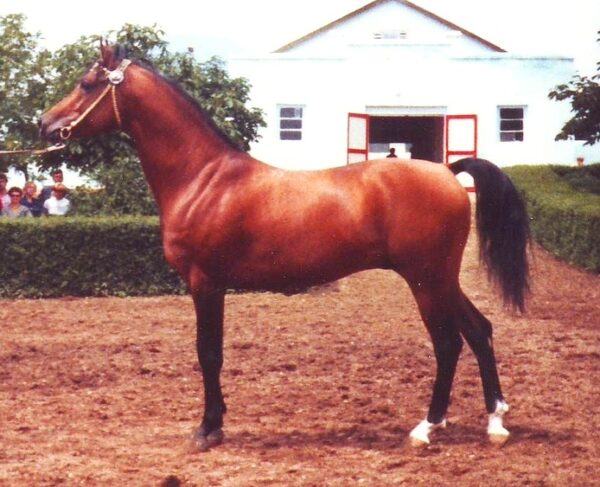
In the interceding years, Menes had become a difficult horse to handle, through no fault of his own. Cindy was fully aware of Menes’ personality, citing the early days they spent together in Holland. “My first indication that Menes was a very different horse came the day he kicked me completely out of the stall,” she says. “He was, without doubt, the most sensitive horse I have ever worked with and he made no apologies for it. He was not nervous or jumpy or skittish – far from it. He was unusually mellow, extremely intelligent and extremely aware of everything that went on around him.
“My mistake was using a nylon finishing brush on Menes and he didn’t like the sound and feel of it. There was no spooking or jumping, just a simple cow-kick that propelled me from his shoulder, out the stall door and onto my back in the aisle.
“The more time we spent together, especially once we were in the US, the more I understood him. Menes didn’t like men and he wouldn’t tolerate being shown with a whip; he made his feelings in that regard perfectly clear. It was his way or the highway. Otherwise, he would do anything you asked and was often exercised by being ridden. He would have been a lovely show horse under saddle, but alas, he was too valuable to haul around on the show circuit.
“In the interim years between when I left and when Menes and I were reunited, he had become a tough horse to handle, due to circumstances that were not his fault; too many photo sessions where stallions were stood nose to nose with him to get that magic image had caused Menes to snap and attack the handler and from that point on, if he were around another male horse, he would go for the handler. I wasn’t afraid of Menes, but I certainly respected his size and power.”
Cindy and Menes undertook the journey to Belgium where, in spite of Cindy’s concerns, Menes settled in very comfortably at Arabica in spite of the other stallion standing there at stud. “From his stall, he could see all of Arabica’s mares, grazing in their paddocks,” explains Cindy. “He had his own large, grassy paddock, too, and he loved it. He loved watching ‘his’ mares with their foals and he would be very gentle with the foals that made there way up to his stall, gumming at Menes as he touched noses with them.”
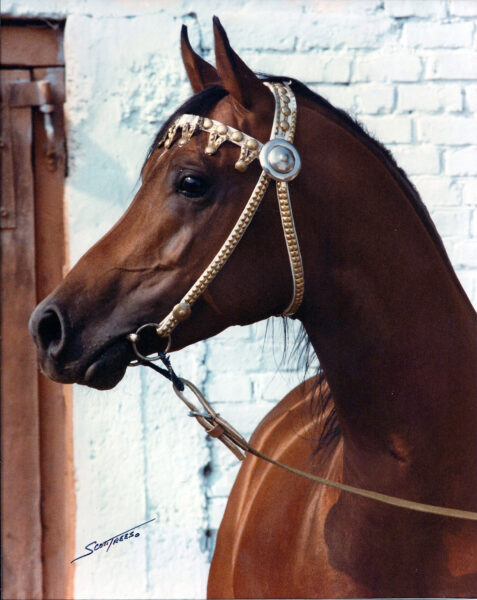
The breeding season at Arabica went well, with Menes covering some of the top mares in Europe including Gaskonia (Probat x Gizela by Palas out of Gilza) from the Michalów State Stud, who foaled the colt Gaskonczyk in 1993.
“It was halfway through that breeding season that we faced our second major crisis with Menes,” recalls Cindy. “Somehow, a loop of intestine had dropped through an opening in the abdominal wall into his scrotum. Menes had been in intense pain and had obviously thrown himself around the stall for some time before he was discovered at 6am. Most horses that have this type of hernia do not survive for long and we were fortunate in that a veterinary surgery was just 20 minutes away; it was a race to see if we could get him there alive.
“Again, the toughness of this horse cannot be underestimated and is a major factor in his survival through adversity. The veterinary surgeon told us that there were three options: he may not survive the surgery, they may have to sacrifice one testicle to save him, or they might have to castrate Menes in order to save him. I replied that they should save both testicles if they could, one if they could, or if they needed to castrate him to save them, then do it. He would be the most expensive gelding in the world, but he could come and live with me in my backyard if that was the outcome.
“Menes not only survived with both testicles intact – minus, of course, three foot of intestine – but he was screaming at the mare in the recovery stall next to him just two hours after surgery. What a horse.”
Menes fully recovered from his surgery and from Arabica, he went to the Kossack Stud in Holland, where he and Cindy had started their journey together nearly 10 years previously. “It was time for me, once more, to leave him and it was very hard to do so,” she recalls. “We had resumed that close bond that we had formed so many years previously on his exit from Russia and saying goodbye to him in Holland was hard.”
Menes ended up living out his days at Forelock Arabians in Holland, owned by the Kuijf family. Cindy visited him just once more during the mid-1990s, and she recalls that he seemed very content with his life. At the time, Cindy wrote: “I have now seen the third generation of Menes horses. His sensitivity to the world around him is uncanny. He was one of the gamest, most honest, smartest and most stable horses that I have ever known. Menes would have been a great horse of any breed; we were just lucky that he was an Arabian.”
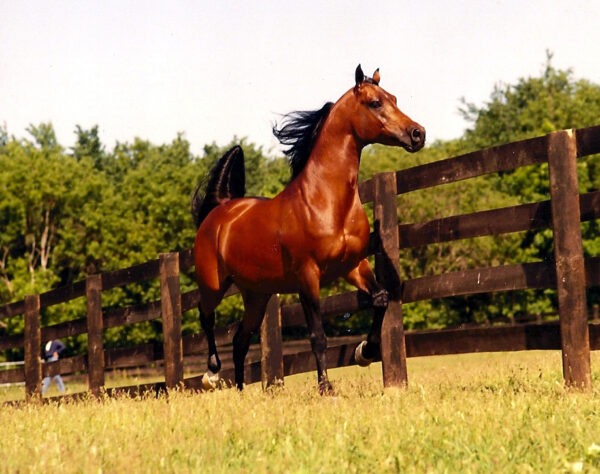
The story of every great horse naturally has to come to an end, and this look back at the life of Menes has not been about his specific achievements as a sire, but about a life shared with one of the legends of the Arabian world. Even today, Menes blood adds a certain depth, a certain quality to a foal and, speaking to Michael and Cindy about their experiences of Menes when they first saw him in Russia, it is clear to see that his prepotency was so great that, 10 years after his death, his strengths still shine through.
This was a horse that I wish I had known, but is one that I can enjoy through the tremendous legacy he has created, which has reached the world over. The determination of the Weinstein’s and Fidelis International allowed the world to share in the joy that was Menes. The vision and foresight of Michael, Lissa and Cindy in recognising the huge qualities of Menes and believing in him enough to go through 18 months of hard negotiations to buy the stallion that was not for sale can never be underestimated, nor can we ever thank them enough for giving us access, through the Iron Curtain, to the incredible beauty that was Menes.
It is only right that Cindy shares her closing thoughts on Menes to end this tribute to this legend. “I had always believed that Menes had been born a few hundred years too late,” she writes. “He would have been a top herd sire, running his mares and foals over the steppes of Russia and giving in to no one. He would have conquered all comers and taken exceptional care of his mares. Menes was a wild horse at heart, but he lived in confinement without complaint; as long as it was on his terms, for the most part.
“Menes was a unique horse and I feel honoured to have been so close to. It came as no surprise that he died in 2001, at the age of 24 years old, covering a mare. He would have gone no other way, I would think.”


